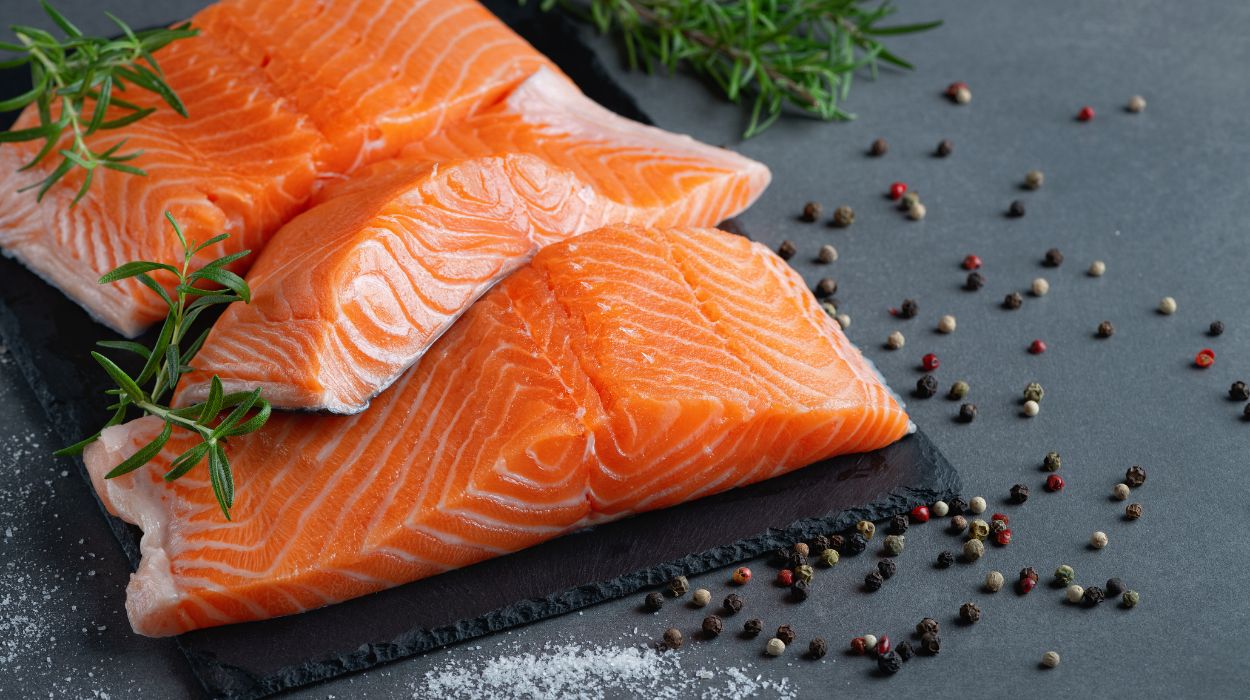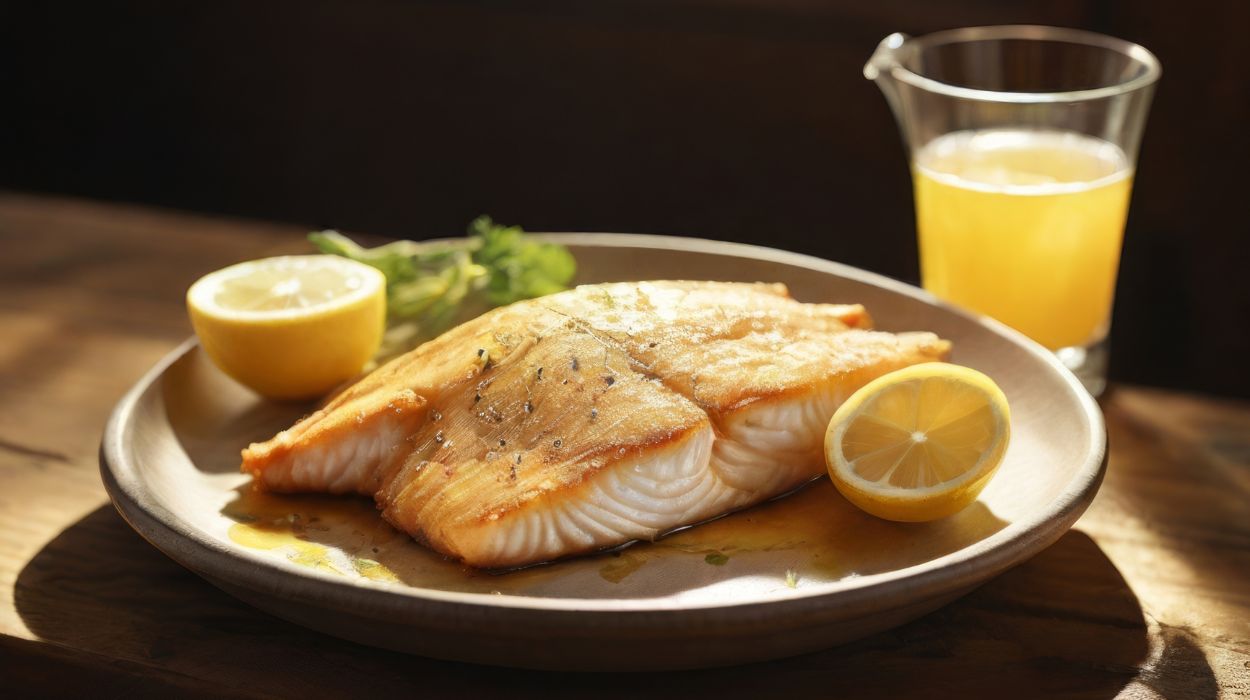 Evidence Based
Evidence Based
Evidence Based
This article is objectively based on relevant scientific literature, written by experienced medical writers, and fact-checked by a team of degreed medical experts.
Our team of registered dietitian nutritionists and licensed medical professionals seek to remain objective and unbiased while preserving the integrity of any scientific debate.
The articles contain evidence-based references from approved scientific sites. The numbers* in parentheses (*1,2,3) will take you to clickable links to our reputable sources.
Is Salmon Good For Diabetics? Seafoods You Should Eat 2024

Based on reports by the CDC[1] (Centers for Disease Control and Prevention), patients with type 2 diabetes are twice as likely to suffer from a stroke or heart disease as those without diabetes.
The Washington State Department of Health[2] reports that fish is full of essential vitamins and minerals, and is also a rich source of healthy fat and protein.
A healthy diet consisting of fish, whole grain bread, chia seeds, starchy vegetables, etc., will benefit your immune system and overall health. A seafood-based diet, to be specific, should be a significant part of your lifestyle plan.
Keep reading to explore the relation between eating salmon, and managing type 2 diabetes.
Is Salmon Good For Diabetes?
Yes. Salmon is considered good for diabetes. It is rich in omega-3 fatty acids, improves cardiovascular health, heart health, and reduces inflammation, both of which are important for managing diabetes. Additionally, salmon is a good source of protein, which can help stabilize blood sugar levels and promote satiety. However, it’s essential to consider portion sizes and cooking methods to avoid adding excess unhealthy fats or sugars to the dish. Overall, incorporating salmon into a balanced diet can be beneficial for individuals with diabetes.
Is Salmon Good For Diabetics?
Yes. Salmon filets, salmon patties, and salmon in sushi are all scrumptious dishes you may eat without realizing just how good they are for diabetes and insulin sensitivity.
Salmon – both canned and fresh – is a rich source of healthy omega-3 fats, protein, and carbohydrates. This means that, by default, salmon aids in weight loss[3] and keeps you feeling fuller for longer. There’s also no risk of your blood sugar rising with every salmon meal you take.
Salmon contains potent antioxidants[4] and goes perfectly well with roasted vegetables or even green salad. You can season it and prepare it in a number of ways or just serve it on its own.
However, if you prepare your salmon filets, ensure you leave them on the skin. Studies[5] have shown that salmon may lower your blood sugar levels by decreasing oxidative stress and inflammation.
Alternatives To Salmon
With that said, here are seven other types of seafood you should often eat to prevent or manage type 2 diabetes:
- Tilapia
- Trout
- Tuna
- Cod
- Sardines
- Shellfish
- Shrimp
Tilapia

Tilapia is a mild-flavored fish that is high in protein and low in calories. According to the U.S. Department of Agriculture[6], a single tilapia filet that has either been poached or steamed contains 28.5 grams of protein and 137 calories.
Tilapia contains selenium, a mineral that helps in balancing glucose levels.
You won’t have to search extensively for it if you want to cook tilapia. It’s cheap, readily available in most fish stores, and sold as frozen and fresh filets.
When preparing tilapia, try not to overcook it. Their thinness makes them cook fast, so don’t let them stay on for too long, or else they’ll start falling apart.
Trout
Trout is a heart-healthy fish that contains high levels of omega-3 fatty acids. It’s packed with vitamin D and protein, both of which are great for those with type 2 diabetes.
You can either broil or bake your trout with citrus juice or sodium-free seasoning. The American Heart Association recommends that you limit your daily sodium intake to less than 2,300 milligrams.
Trout has its own unique flavor, thus lessening the need to add a ton of salt.
Tuna

Tuna is another tasty seafood dish that offers a variety of health benefits, along with a steady supply of vitamin D, omega-3 fatty acids, and protein. It also provides a host of other micronutrients, including zinc, phosphorus, magnesium, and calcium that are beneficial for diabetic patients.
Many people with diabetes also struggle with high cholesterol in their blood. Tuna lessens that problem due to its significantly low saturated fats and carbohydrates.
Opt for tuna that’s preserved in water[7] rather than oil to lower your fat and calorie intake. As healthy as tuna may be, it’s recommended to limit it to 2-3 servings[8], or 12 ounces per week to prevent overconsumption of mercury.
Freshwater, canned light tuna is one of the best seafood choices since it is lower in mercury.
Cod
Cod is a white high-protein and low-calorie fish with a healthy portion of omega-3 fatty acids and lean protein. The USDA[9] notes that a poached or steamed filet contains 32.6 grams of protein and 148 calories.
The omega-3 fats in cod assist in decreasing blood sugars, which can reduce your risk of heart disease. Consuming omega-3 fatty acids[10] may be an even better solution than lowering your salt intake when it comes to keeping your blood pressure in check.
Cod contains selenium and phosphorus – two crucial minerals that satisfy your dietary requirements[11] as a person with diabetes. Selenium[12] improves your lipidemic and glycemic profile, while phosphorous[13] aids in the regulation of insulin sensitivity
You can prepare cod in various ways, including pan-frying, grilling, broiling, grilling, and baking. Overcooking it may dry it out, especially if it was previously frozen.
Sardines
Sardines are a good source of calcium and a rich source of vitamin D and omega-3s. The USDA[14] reports that canned sardines offer 1.36 mcg of vitamin D and 108 mg of calcium.
This nutritional makeup makes sardines excellent seafood for diabetics. It’s recommended to seek out a brand with low sodium levels, fat, and other unnecessary additives.
Sardines offer 2 grams of omega-3s for every 3-ounce serving. This is, by far, the highest portion of omega-3 of any fish. This heart-healthy fish can be packed in olive oil, tomato juice, or water.
Perhaps the most important part of fresh sardines is their rich protein content. Protein in sardines helps to reduce blood sugar, stimulate metabolism, and make you feel full.
Shellfish
Three of the best shellfish for diabetes are crab, lobster, and shrimp.
Of all the fish on this list, shellfish are among the healthiest seafood options for diabetics. These fatty fish are rich in nutrients like zinc, vitamin B12, and omega-3 fatty acids, all of which are essential in promoting a healthy immune system and managing diabetes.
Despite that, shellfish lower your chances of heart disease, obesity, and diabetes. They’re also known to promote healthy cholesterol levels, which is especially helpful for those with diabetes who are at an increased risk of having high cholesterol.
Crabs are a rich source of chromium that aids in sugar metabolism. This helps in reducing inflammation and lowering blood glucose levels.
Shrimp
Shrimp is another good diabetes-friendly fish choice. The USDA[15] reports that a single 4-oz shrimp serving contains about 23 grams of protein and 120 calories. Compared to other seafood on this list, shrimp has a relatively higher level of saturated fat (approximately 170 mg). You may, therefore, want to skip it if you’re trying to lose weight.
Regardless, shrimp is still a great food option in terms of preventing and managing blood glucose levels. It doesn’t contain lots of unsaturated fats, and its high protein content helps stabilize the blood sugar in your blood.
Shrimp’s low glycemic index helps to increase your satiety[16], thereby lowering your carb intake. Shrimp also contains an antioxidant known as astaxanthin, a compound found in algae. This compound is primarily responsible[17] for its reddish shade.
There are many health benefits of consuming astaxanthin. For one, it helps strengthen your arteries, thereby lowering your chances[18] of various chronic illnesses. It’s also believed to boost HDL cholesterol levels (healthy fats), which is excellent for your overall heart health. Blood sugar level
The USDA[19] estimates that shellfish in general only have 1 gram of dietary cholesterol and approximately 97 calories. To limit added calories and fat, be careful not to add melted butter during preparation. The calories and fat contents may skyrocket and make them ineffective for managing diabetes.
Conclusion
In conclusion, incorporating seafood into the diet, particularly options like salmon, can be beneficial for individuals with type 2 diabetes. Salmon, rich in omega-3 fatty acids, protein, and other essential nutrients, offers numerous advantages for managing diabetes and promoting overall health. By improving cardiovascular health and providing essential nutrients, salmon consumption can contribute to better blood sugar control and reduced risk of complications associated with diabetes. While supplements may offer some benefits, whole foods like salmon provide a more comprehensive nutritional profile. Therefore, including salmon and other seafood in the diet can be a valuable strategy for individuals with type 2 diabetes looking to optimize their health and well-being.
+ 19 sources
Health Canal avoids using tertiary references. We have strict sourcing guidelines and rely on peer-reviewed studies, academic researches from medical associations and institutions. To ensure the accuracy of articles in Health Canal, you can read more about the editorial process here
- CDC (2021). Diabetes and Your Heart. [online] Centers for Disease Control and Prevention. Available at: https://www.cdc.gov/diabetes/library/features/diabetes-and-heart.html
- Wa.gov. (2019). Health Benefits of Fish. [online] Available at: https://www.doh.wa.gov/communityandenvironment/food/fish/healthbenefits#
- Ramel, A., Martinez, J.A., Kiely, M., Bandarra, N.M. and Thorsdottir, I. (2010). Effects of weight loss and seafood consumption on inflammation parameters in young, overweight and obese European men and women during 8 weeks of energy restriction. European Journal of Clinical Nutrition, [online] 64(9), pp.987–993. Available at: https://pubmed.ncbi.nlm.nih.gov/20551965/
- Hamre, K., Sissener, N.H., Lock, E.-J., Olsvik, P.A., Espe, M., Torstensen, B.E., Silva, J., Johansen, J., Waagbø, R. and Hemre, G.-I. (2016). Antioxidant nutrition in Atlantic salmon (Salmo salar) parr and post-smolt, fed diets with high inclusion of plant ingredients and graded levels of micronutrients and selected amino acids. PeerJ, [online] 4, p.e2688. Available at: https://www.ncbi.nlm.nih.gov/pmc/articles/PMC5103829/
- Zhu, C.-F., Peng, H.-B., Liu, G.-Q., Zhang, F. and Li, Y. (2010). Beneficial effects of oligopeptides from marine salmon skin in a rat model of type 2 diabetes. Nutrition, [online] 26(10), pp.1014–1020. Available at: https://pubmed.ncbi.nlm.nih.gov/20541363/
- Usda.gov. (2021). FoodData Central. [online] Available at: https://fdc.nal.usda.gov/fdc-app.html#/food-details/1099076/nutrients
- Usda.gov. (2021). FoodData Central. [online] Available at: https://fdc.nal.usda.gov/fdc-app.html#/food-details/1099041/nutrients
- ADVICE ABOUT EATING FISH. (n.d.). [online] Available at: https://www.fda.gov/media/102331/download.
- Usda.gov. (2021). FoodData Central. [online] Available at: https://fdc.nal.usda.gov/fdc-app.html#/food-details/1098815/nutrients
- Hoshi, T., Wissuwa, B., Tian, Y., Tajima, N., Xu, R., Bauer, M., Heinemann, S.H. and Hou, S. (2013). Omega-3 fatty acids lower blood pressure by directly activating large-conductance Ca2+-dependent K+ channels. Proceedings of the National Academy of Sciences, [online] 110(12), pp.4816–4821. Available at: https://www.ncbi.nlm.nih.gov/pmc/articles/PMC3607063/
- Nationalacademies.org. (2021). [online] Available at: https://www.nationalacademies.org/hmd/~/media/Files/Activity%20Files/Nutrition/DRI-Tables/2_%20RDA%20and%20AI%20Values_Vitamin%20and%20Elements.pdf?la=en
- Karalis, D.T. (2019). The Beneficiary Role of Selenium in Type II Diabetes: A Longitudinal Study. Cureus. [online] Available at: https://www.ncbi.nlm.nih.gov/pmc/articles/PMC6973540/
- LIN, Y., BERGER, L. and SUN, Z. (2018). Regulation of Insulin Sensitivity by Phosphorus. Diabetes, [online] 67(Supplement 1), pp.1772-P. Available at: https://diabetes.diabetesjournals.org/content/67/Supplement_1/1772-P
- Usda.gov. (2021). FoodData Central. [online] Available at: https://fdc.nal.usda.gov/fdc-app.html#/food-details/1098983/nutrients
- Usda.gov. (2021). FoodData Central. [online] Available at: https://fdc.nal.usda.gov/fdc-app.html#/food-details/452111/nutrients
- Kaur, B., Ranawana, V., Teh, A.-L. and Henry, C.J.K. (2015). The impact of a low glycemic index (GI) breakfast and snack on daily blood glucose profiles and food intake in young Chinese adult males. Journal of Clinical & Translational Endocrinology, [online] 2(3), pp.92–98. Available at: https://www.sciencedirect.com/science/article/pii/S2214623715000563
- Grimmig, B., Kim, S.-H., Nash, K., Bickford, P.C. and Douglas Shytle, R. (2017). Neuroprotective mechanisms of astaxanthin: a potential therapeutic role in preserving cognitive function in age and neurodegeneration. GeroScience, 39(1), pp.19–32.
- Ambati, R., Phang, S.-M., Ravi, S. and Aswathanarayana, R. (2014). Astaxanthin: Sources, Extraction, Stability, Biological Activities and Its Commercial Applications—A Review. Marine Drugs, 12(1), pp.128–152.
- Usda.gov. (2021). FoodData Central. [online] Available at: https://fdc.nal.usda.gov/fdc-app.html#/food-details/1099116/nutrients



